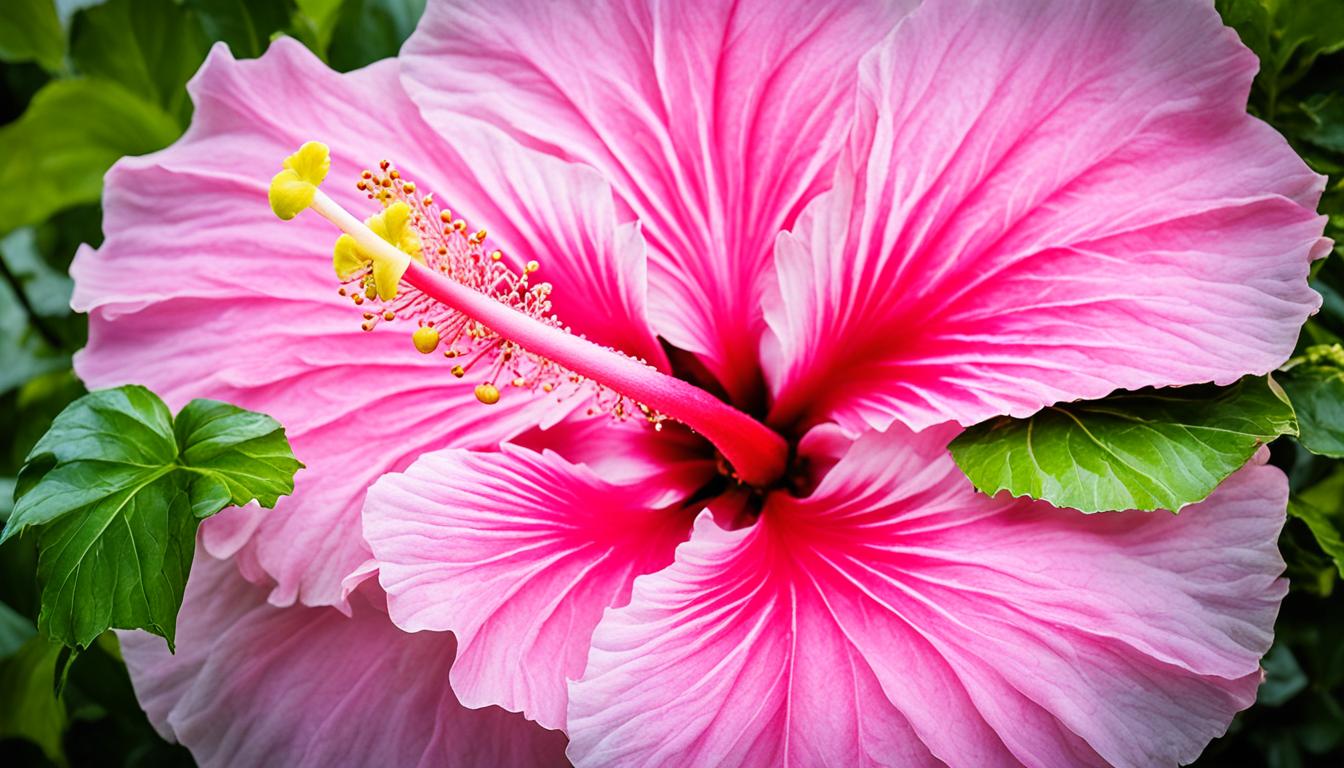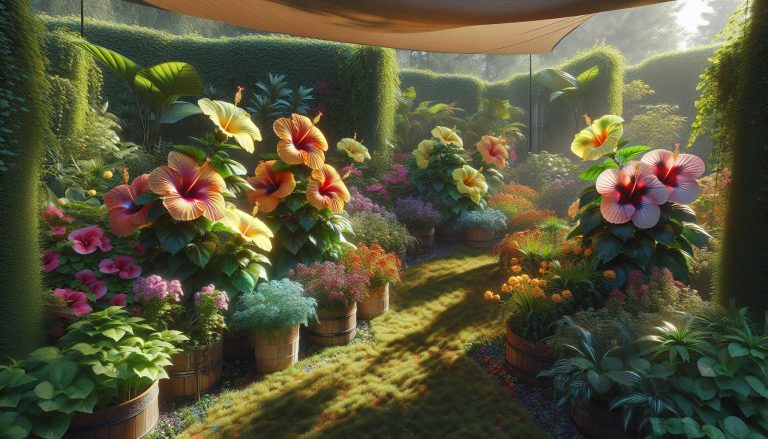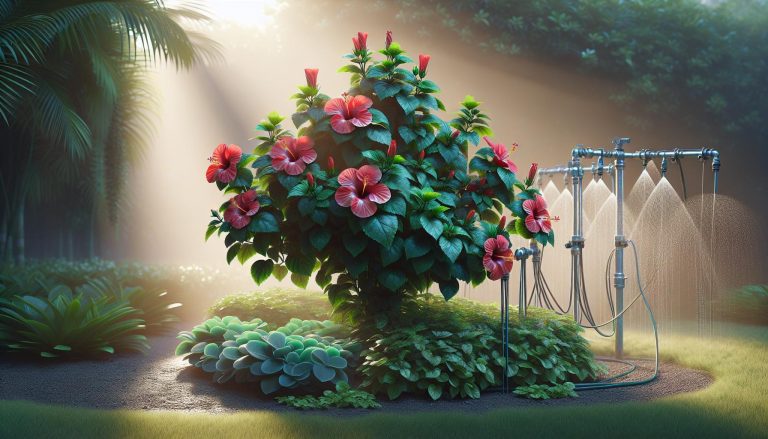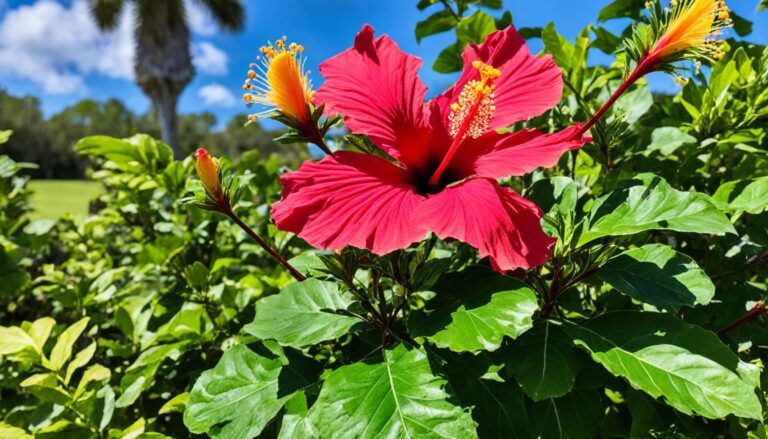Discover the Beauty of Pink Hibiscus Flowers!
Imagine strolling through a vibrant garden, surrounded by a sea of lush greenery and dazzling colors. As you wander deeper into this enchanting paradise, your eyes are drawn to a mesmerizing sight—a cluster of delicate pink hibiscus flowers, their vibrant petals dancing in the gentle breeze. In that moment, time seems to stand still, and you can’t help but feel a sense of awe and wonder at the exotic beauty before you.
Pink hibiscus flowers, scientifically known as Hibiscus rosa-sinensis, are a true tropical delight. Their lush foliage and enchanting blooms make them a must-have for any garden enthusiast or nature lover. These exquisite flowers not only add a touch of elegance to your outdoor space, but they also have a rich history and cultural significance that spans centuries. From their stunning appearance to their healing properties, pink hibiscus flowers hold a special place in the world of flora and captivate hearts wherever they bloom.
Key Takeaways:
- Pink hibiscus flowers, also known as Hibiscus rosa-sinensis, are a tropical flower renowned for their stunning beauty.
- These exotic blooms add vibrant color and elegance to garden landscaping, making them a favorite choice among gardeners.
- Hibiscus rosa-sinensis has a rich history and cultural significance, symbolizing beauty, love, and femininity in various traditions.
- The healing properties of pink hibiscus flowers, such as their anti-inflammatory and antioxidant properties, make them a popular ingredient in traditional medicine.
- Whether you admire them for their visual appeal, connect with their cultural significance, or appreciate their healing properties, pink hibiscus flowers are a true treasure and can transform your garden into a haven of natural wonder.
The History and Characteristics of Hibiscus rosa-sinensis
Hibiscus rosa-sinensis, commonly known as Chinese hibiscus or tropical hibiscus, is an evergreen shrub native to East Asia, particularly China and the Pacific Islands. This exquisite plant has a rich history and is cherished for both its ornamental value and medicinal properties.
One of the most striking features of Hibiscus rosa-sinensis is its vibrant flowers. These large blooms come in a wide range of colors, including pink, red, orange, yellow, and white. Each flower lasts for only a day or two, but the plant continuously produces new blooms throughout the growing season, ensuring a constant display of beauty in your garden.
Aside from its ornamental value, Hibiscus rosa-sinensis has been used in traditional medicine for centuries. The plant is known for its medicinal properties, which include anti-inflammatory and antioxidant effects. The flowers are often brewed into tea to treat various ailments and promote overall well-being.
While the flowers of Hibiscus rosa-sinensis are captivating, it’s important to note that the plant has a relatively short lifespan. However, its evergreen nature ensures that it remains a stunning addition to your garden year-round.
Let’s explore the history and characteristics of Hibiscus rosa-sinensis in more detail:
Ornamental Value
Hibiscus rosa-sinensis has been prized for its ornamental value for centuries. Its vibrant flowers and lush foliage make it a popular choice for garden landscaping and adding a tropical touch to any outdoor space. Whether used as a focal point or mixed with other plants, the vibrant blooms of Hibiscus rosa-sinensis never fail to create a striking visual impact.
Medicinal Properties
In addition to its ornamental value, Hibiscus rosa-sinensis has long been recognized for its medicinal properties. The plant is known for its anti-inflammatory and antioxidant effects, making it a valuable component of traditional medicine. The flowers of Hibiscus rosa-sinensis are often used to brew tea, which is believed to have numerous health benefits, including promoting skin health and reducing inflammation.
Evergreen Shrub
Hibiscus rosa-sinensis is an evergreen shrub, meaning it retains its foliage throughout the year. This allows for a consistent display of vibrant flowers and lush green leaves, adding beauty to your garden even in colder months. The evergreen nature of the plant also ensures that it maintains its ornamental value and visual appeal year-round.
As we continue our journey into the world of Hibiscus rosa-sinensis, we will explore the care and growing conditions necessary for this plant to thrive. Stay tuned for the next section where we will delve into the specifics of nurturing this tropical beauty.
Care and Growing Conditions for Hibiscus rosa-sinensis
To successfully grow Hibiscus rosa-sinensis, it is important to provide the right care and growing conditions. Here are some key factors to consider:
Well-Draining Soil
The hibiscus plant thrives in well-draining soil. Make sure the soil has good drainage to prevent excessive moisture and root rot. A well-draining soil allows water to flow freely through it, preventing waterlogged conditions and promoting healthy root development. It also helps to maintain the right balance of moisture for the plant.
Slightly Acidic pH
Hibiscus rosa-sinensis prefers a slightly acidic pH level between 6.0 and 6.5. This acidic environment ensures optimal nutrient uptake and supports healthy growth. You can test the soil pH using a soil testing kit and adjust it if necessary.
Full Sun or Partial Shade
Hibiscus plants love full sun but can tolerate partial shade as well. For the best results, provide at least 6 hours of direct sunlight daily. This will encourage vigorous growth and vibrant flowering. If you live in a region with intense heat, partial shade during the hottest part of the day can help protect the plant from scorching.
Regular Watering
Hibiscus plants require regular watering to keep the soil moist but not waterlogged. Water deeply and thoroughly to ensure proper hydration of the roots. During the growing season, monitor the moisture levels and adjust your watering schedule accordingly. Reduce watering during the winter months when the plant is dormant.
Fertile Soil
Provide your hibiscus plant with fertile soil that is rich in organic matter. This will supply the necessary nutrients for healthy growth and vibrant blooms. Incorporate well-composted manure or organic matter into the soil before planting, and consider using a slow-release fertilizer during the growing season to ensure a continuous supply of nutrients.
Pruning
Pruning is an essential part of hibiscus care. It helps maintain the plant’s shape, encourages branching, and promotes healthy growth. Prune your hibiscus in late winter or early spring before new growth emerges. Remove dead or damaged branches, as well as any branches that are crossing or rubbing against each other. This will improve air circulation and reduce the risk of disease.
| Growing Conditions | Care Tips |
|---|---|
| Well-Draining Soil | Ensure good drainage to avoid waterlogged conditions. |
| Slightly Acidic pH | Maintain a pH level between 6.0 and 6.5. |
| Full Sun or Partial Shade | Provide at least 6 hours of direct sunlight per day. |
| Regular Watering | Keep the soil consistently moist but not waterlogged. |
| Fertile Soil | Use organic matter and slow-release fertilizers to provide nutrients. |
| Pruning | Prune in late winter or early spring to maintain shape and promote healthy growth. |
By following these care guidelines and providing the right growing conditions, you can enjoy the vibrant blooms and beauty of Hibiscus rosa-sinensis in your garden.
How to Use Hibiscus rosa-sinensis
Hibiscus rosa-sinensis is a versatile plant that can be used in various ways to enhance your gardening experience. Whether you’re looking to create a stunning landscape design, venture into container gardening, or bring a tropical touch indoors, hibiscus rosa-sinensis can fulfill your desires.
Landscape Design
In landscape design, hibiscus rosa-sinensis can serve as a beautiful focal point. Its vibrant flowers and lush green foliage create a visually striking display that can instantly elevate the overall aesthetics of your outdoor space. You can place hibiscus rosa-sinensis in strategic locations, such as at the entrance of your garden or along walkways, to draw attention and add a pop of color.
Container Gardening
For those with limited garden space or who live in apartments or condos, hibiscus rosa-sinensis is an ideal choice for container gardening. You can plant it in large, decorative pots and place them on your patio, balcony, or any suitable outdoor area. This allows you to enjoy the beauty of hibiscus rosa-sinensis even in small spaces. Just make sure to choose a pot with good drainage and provide regular watering.
Indoor Gardening
Yes, you can even grow hibiscus rosa-sinensis indoors! With the right care and attention, you can bring the tropical touch of hibiscus flowers into your home. Place your hibiscus plant near a natural light source, such as a sunny window, to ensure it receives adequate sunlight. Regular watering and periodic fertilization will help maintain its health and vitality. Just imagine the joy of having vibrant hibiscus blooms brightening up your living space.
| Uses of Hibiscus rosa-sinensis | Benefits |
|---|---|
| Landscape Design | Creates a focal point in garden landscapes |
| Container Gardening | Perfect for small garden spaces and balconies |
| Indoor Gardening | Brings a tropical touch to your home |
No matter how you choose to use hibiscus rosa-sinensis, it will surely add beauty and vibrancy to your garden or indoor space. Experiment with different arrangements, color combinations, and planting styles to create a personalized and captivating environment. The possibilities are endless when it comes to this versatile and stunning plant.
The Unique Features of the HibisQs Varieties
The HibisQs collection offers a selection of hybrid Hibiscus rosa-sinensis varieties that showcase exceptional flower size, a wide color range, and an extended blooming period. These hybrid varieties are renowned for their stunning double-layered flowers in vibrant colors, including vivid reds, oranges, yellows, pinks, and whites. One of the key advantages of the HibisQs varieties is their ability to produce large blossoms that add a striking visual impact to any garden or landscape.
With their vibrant blooms and robust performance, the HibisQs varieties are perfect for garden enthusiasts who are looking for eye-catching flowers that will truly stand out. These hybrids exhibit a longer blooming season compared to their counterparts, providing extended periods of delightful color throughout the year.
Another notable feature of the HibisQs varieties is their unparalleled flower size. These hybrids often produce exceptionally large blossoms with a diameter that surpasses standard hibiscus flowers. The impressive size of the blooms further enhances their visual appeal, making them a centerpiece in any floral display.
Color Range
The HibisQs collection boasts an impressive color range, offering an extensive palette of vibrant hues. From fiery reds and oranges to cheerful yellows, soothing pinks, and pristine whites, these hybrids cater to various color preferences and allow gardeners to create captivating displays with diverse color combinations.
Compact Growth Habit
Many of the HibisQs varieties have been selectively bred with a more compact growth habit, making them suitable for smaller garden spaces or container gardening. This unique characteristic allows hibiscus enthusiasts with limited room to enjoy the beauty and charm of these exceptional hybrids, even in more confined settings.
With their exceptional flower size, vibrant colors, and extended blooming periods, the HibisQs varieties are a top choice for those who seek to add a touch of exotic beauty and elegance to their outdoor spaces. Whether used as a focal point in a flowerbed or as part of a larger planting scheme, the HibisQs hybrids are sure to captivate with their exceptional qualities and vibrant presence.
HibisQs Varieties Overview
| Variety | Flower Size | Color | Blooming Period |
|---|---|---|---|
| HibisQs Red Ace | Large | Red | Long |
| HibisQs Sunset Glow | Extra Large | Orange | Extended |
| HibisQs Lemon Zest | Medium | Yellow | Year-round |
| HibisQs Pink Delight | Large | Pink | Continuous |
| HibisQs Snowflake | Extra Large | White | Consistent |
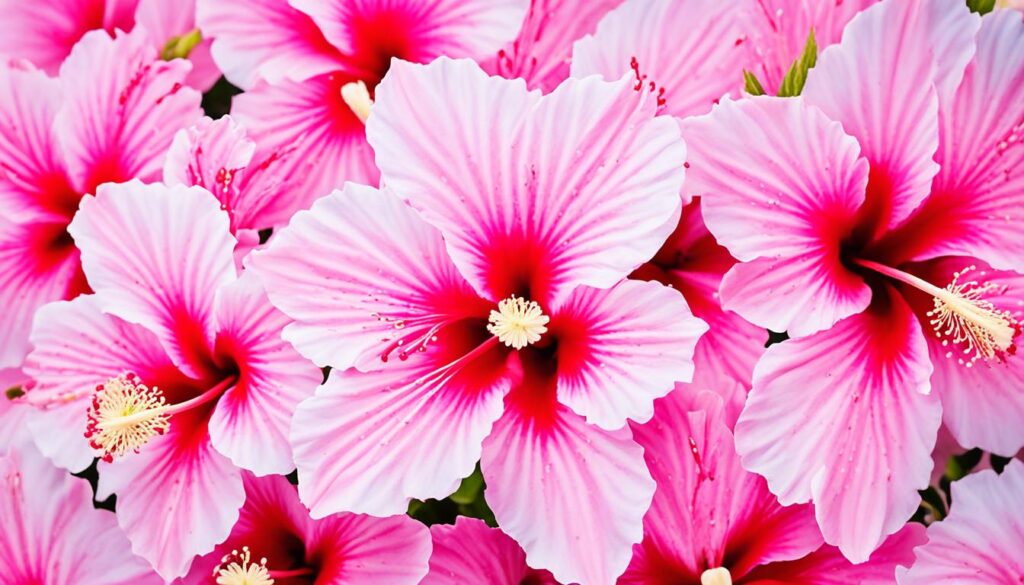
Creating Breathtaking Displays with Pink Hibiscus Flowers
Pink hibiscus flowers have the power to create stunning displays in garden landscapes. With their vibrant blooms and exotic beauty, these flowers stand out and add a visual impact that is hard to ignore. Whether used as a focal point or as part of a larger planting scheme, pink hibiscus flowers have the ability to enhance the overall aesthetic of any garden.
One of the key advantages of pink hibiscus flowers is their versatility when it comes to color palettes. These vibrant blooms can be incorporated into various color schemes, allowing for stunning combinations that capture attention and create a harmonious visual appeal. Whether paired with other shades of pink for a monochromatic look or contrasted with vibrant blues and purples for a bold statement, pink hibiscus flowers have the ability to create breathtaking displays that leave a lasting impression.
When designing a garden landscape, it’s important to consider the visual impact that pink hibiscus flowers can bring. Their vibrant blooms and exotic beauty can serve as a focal point, drawing the eye and adding interest to different areas of the garden. Whether planted in groups or strategically placed along pathways, pink hibiscus flowers have the power to create a captivating visual experience for anyone who enters the space.
To fully appreciate the beauty and impact of pink hibiscus flowers, consider planting them in areas where they can be easily admired. Whether it’s near a seating area or positioned to frame a stunning view, these flowers have the ability to delight and captivate viewers with their vibrant blooms and unique charm.
| Benefits of Pink Hibiscus Flowers in Garden Landscapes |
|---|
| 1. Create stunning focal points in garden design |
| 2. Add vibrant color and visual appeal |
| 3. Enhance the overall aesthetic of garden landscapes |
| 4. Incorporate into various color palettes for stunning combinations |
| 5. Attract attention and leave a lasting impression |
Tips for Successful Pink Hibiscus Flower Care
Caring for pink hibiscus flowers requires attention to essential aspects such as soil preparation, watering, fertilizing, pruning, and winter protection. By implementing these care tips, you can ensure that your pink hibiscus plants thrive and reward you with vibrant blooms.
Soil Preparation
Before planting pink hibiscus flowers, it is crucial to prepare the soil properly. Ensure that the soil has well-draining conditions by incorporating organic matter like compost, peat moss, or well-rotted manure. This will promote healthy root development and prevent waterlogging, which can lead to root rot.
Watering
Proper watering is essential for pink hibiscus care, especially during hot and dry periods. Water your plants regularly, keeping the soil consistently moist but not waterlogged. Avoid letting the soil dry out completely between watering sessions, as this can stress the plant and affect its overall health and blooming potential.
Fertilizing
To promote healthy growth and vibrant blooms, it is important to fertilize pink hibiscus flowers regularly. Apply a balanced fertilizer with a ratio of 10-10-10 or a similar composition every 4-6 weeks during the growing season. Follow the instructions on the fertilizer packaging for proper application and dosage.
Pruning
Pruning plays a crucial role in maintaining the shape and health of pink hibiscus plants. Remove any dead, diseased, or damaged branches as soon as you notice them. Additionally, prune your hibiscus in late winter or early spring to encourage new growth and shape the plant as desired.
Winter Protection
During winter, it is important to provide adequate protection for your pink hibiscus plants to prevent cold damage. If you live in a region with freezing temperatures, consider bringing your potted hibiscus indoors. For plants in the ground, you can protect them by covering them with blankets or burlap during frosty nights. Mulching the soil around the base of the plant can also help insulate the roots.
By following these tips for pink hibiscus flower care, you can ensure that your plants thrive and showcase their stunning blooms throughout the growing season.
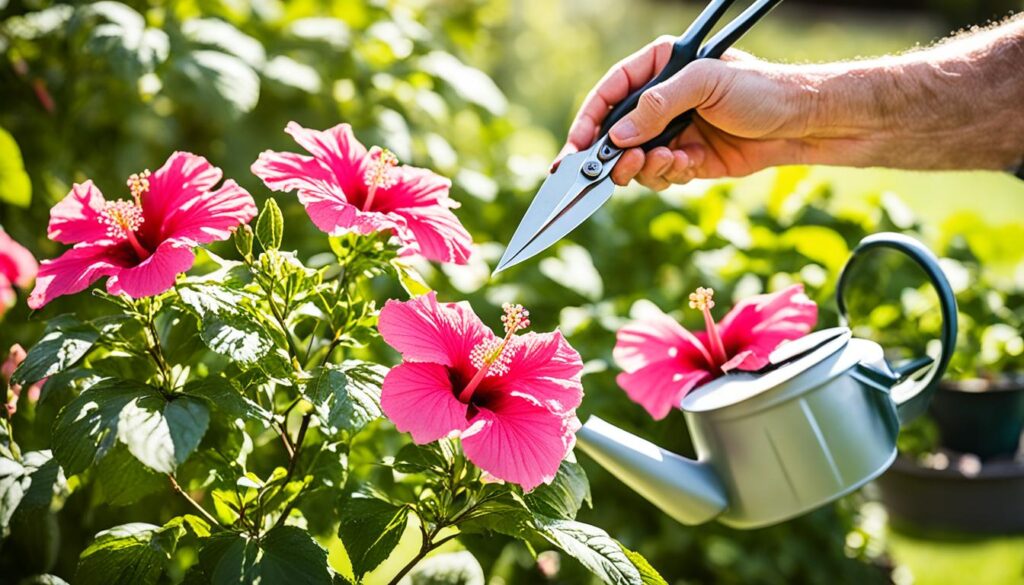
The Healing Properties of Pink Hibiscus Flowers
Pink hibiscus flowers have long been revered for their healing properties and are widely used in traditional medicine. One of the most popular ways to harness the benefits of these flowers is by brewing a soothing cup of hibiscus tea. This delightful beverage is not only refreshing but also offers numerous health benefits.
Anti-inflammatory and Skin Conditions
Hibiscus tea is known for its anti-inflammatory properties, which can help reduce swelling, alleviate pain, and promote overall well-being. It is often used as a natural remedy for various skin conditions, including acne, eczema, and psoriasis. The antioxidants present in pink hibiscus flowers help protect the skin from oxidative stress and may contribute to a healthier complexion.
Rich in Antioxidants
Pink hibiscus flowers are packed with antioxidants, which are essential for combating free radicals in the body. Free radicals can cause cellular damage and contribute to aging and various diseases. By including hibiscus tea in your daily routine, you can help protect your cells from damage and support your overall health and well-being.
Traditional Medicinal Uses
In traditional medicine, pink hibiscus flowers have been used for centuries to treat a range of ailments. The flowers are believed to have diuretic properties that can help with fluid retention and promote healthy kidney function. They are also known for their potential to lower blood pressure and cholesterol levels, making them a valuable addition to a holistic approach to wellness.
Incorporating Pink Hibiscus Flowers into Your Routine
There are various ways to enjoy the healing benefits of pink hibiscus flowers in your daily life. Brewing a cup of hibiscus tea is a simple and delicious way to reap the rewards. You can also find hibiscus-infused skincare products that harness the flower’s natural rejuvenating properties. Whether enjoyed as a tea or incorporated into your skincare routine, pink hibiscus flowers can provide a gentle and effective way to support your health and well-being.
| Healing Properties | Traditional Medicine Uses |
|---|---|
| Anti-inflammatory | Skin conditions |
| Antioxidants | Diuretic properties |
| Lowering blood pressure and cholesterol levels |
Pink Hibiscus Flowers in Cultural Traditions
Pink hibiscus flowers have a deep-rooted significance in cultural traditions around the world. These stunning blooms are closely associated with beauty, love, and femininity. In various cultures, hibiscus flowers play a vital role in rituals and celebrations, symbolizing different aspects of life. Their vibrant color and delicate petals make them a popular choice for decorations during joyous occasions and festive festivals.
The symbolism of pink hibiscus flowers transcends borders and connects people through their universal understanding of beauty, love, and femininity. They are admired for their captivating appearance and evoke a sense of wonder and appreciation for the natural world.
Let’s explore some of the cultural traditions where pink hibiscus flowers hold special significance:
1. Hawaiian Culture
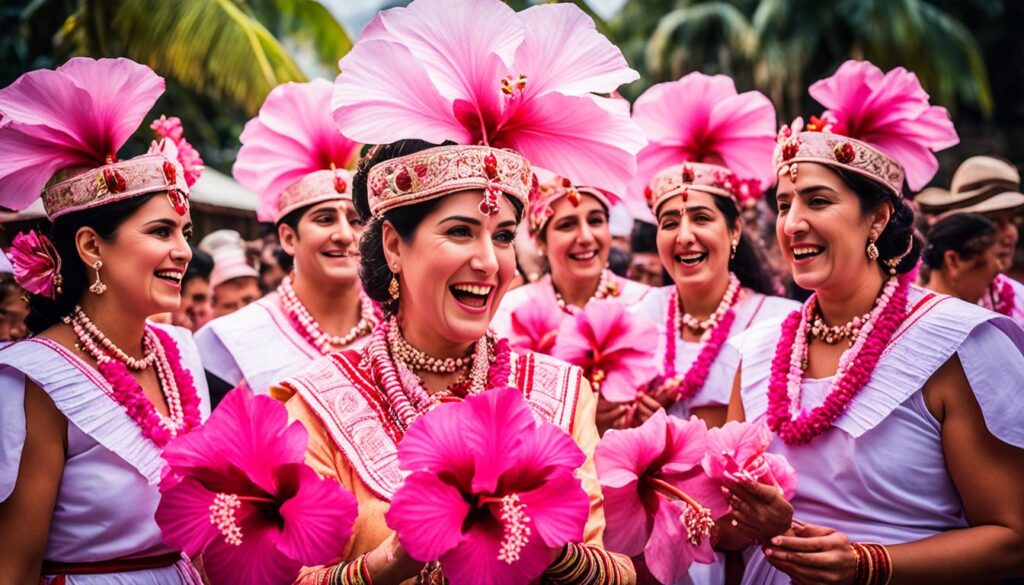
In Hawaiian culture, the hibiscus flower, known as the “pua aloalo,” is the state flower and represents beauty, luxury, and power. It holds a special place in the hearts of the Hawaiian people and is commonly used in leis, which are given as symbols of love and affection.
2. Indian Weddings
In Indian weddings, pink hibiscus flowers are often used in intricate floral arrangements and garlands. They symbolize purity, beauty, and the auspiciousness of a new beginning. These vibrant blooms adorn the venue, bringing a touch of elegance and grace to the auspicious occasion.
3. Chinese Festivals
In Chinese culture, hibiscus flowers are associated with femininity and are admired for their delicate beauty. During the Lantern Festival, the hibiscus takes center stage in vibrant displays, representing joy, life, and the upcoming arrival of spring.
4. Tahitian Dance
In Tahitian dance and culture, pink hibiscus flowers are an integral part of traditional attire. They are worn behind the ear, symbolizing femininity, love, and natural beauty. The flower’s vibrant color adds an enchanting touch to the dancers’ movements.
5. Nigerian Traditions
In Nigerian traditions, hibiscus flowers, known as “zobo,” are used to create a popular drink called “hibiscus tea” or “sorrel.” The tea is enjoyed during celebrations and gatherings, signifying hospitality, unity, and happiness.
The cultural significance of pink hibiscus flowers adds depth and meaning to various traditions and celebrations across the globe. Their beauty and symbolism continue to captivate and inspire generations, bridging cultural gaps and reminding us of the universal themes of love, femininity, and the wonders of nature.
| Culture | Symbolism |
|---|---|
| Hawaiian | Beauty, luxury, power |
| Indian | Purity, beauty, new beginnings |
| Chinese | Femininity, joy, spring |
| Tahitian | Femininity, love, natural beauty |
| Nigerian | Hospitality, unity, happiness |
Pink Hibiscus Flowers in Art and Literature
Pink hibiscus flowers have long served as a muse for artists and writers, inspiring creative expressions across various art forms. The symbolism of these vibrant blooms in art and literature captures the essence of beauty and nature, intertwining their delicate petals and vivid colors with metaphorical depth.
Symbolism in Paintings
In paintings, pink hibiscus flowers often symbolize the ephemeral beauty of life and the ever-changing nature of existence. Artists use the vibrant colors and intricate details of the flowers to convey a sense of vitality and the transient nature of time. Through their brushstrokes, they capture the fleeting moments of blooming petals, inviting viewers to contemplate the transience of life’s most beautiful moments.
Metaphors in Poems
Poets have woven the symbolism of pink hibiscus flowers into their verses, using their elegance and grace as metaphors for diverse emotions and concepts. The softness of their petals may symbolize tenderness and love, while their vibrant colors evoke passion and desire. Their presence in poems often enriches the imagery and adds depth to the poet’s message, creating a tapestry of emotions that resonates with readers.
| Literary Works | Author | Synopsis |
|---|---|---|
| The Secret Garden | Frances Hodgson Burnett | A beloved children’s novel that features a hidden garden blooming with various flowers, including pink hibiscus. The garden serves as a metaphorical refuge and catalyst for personal growth for the characters in the story. |
| The Great Gatsby | F. Scott Fitzgerald | Fitzgerald uses pink hibiscus flowers as a symbolic representation of the fleeting nature of dreams and desires in the Jazz Age. The flowers appear in the opulent gardens of the wealthy characters, highlighting the superficiality of their lifestyles. |
| Cezanne’s Quarry | Barbara Corrado Pope | This historical novel set in 19th-century France features pink hibiscus flowers as a recurring motif in the protagonist’s journey of self-discovery. The flowers symbolize resilience, transformation, and the power of embracing one’s true nature. |
Through art and literature, pink hibiscus flowers transcend their physical beauty and evoke deep emotions within audiences. They remind us of the profound connection between humans and nature, inspiring us to appreciate the fleeting moments and find meaning in the intricate details that surround us.
Pink Hibiscus Flowers in Wedding Decor
Pink hibiscus flowers are a popular choice for wedding decor. Their vibrant pink color and delicate petals add a touch of romance to the overall theme of the wedding, creating a visually stunning and memorable atmosphere.
These beautiful flowers can be incorporated into various aspects of wedding decor, including floral arrangements, centerpieces, bouquets, and bridal accessories. The vibrant hue of the hibiscus flowers adds a joyful and lively element to the celebration, setting a cheerful and romantic tone.
When used in floral arrangements and centerpieces, pink hibiscus flowers create a visually striking focal point. Their vibrant color and unique structure make them stand out, adding a wow factor to the overall decor.
The Versatility of Pink Hibiscus Flowers
Pink hibiscus flowers can be arranged in various ways to suit different wedding styles and themes. Whether you’re going for a classic, rustic, bohemian, or tropical theme, pink hibiscus flowers can be incorporated seamlessly.
For a classic wedding, elegant floral arrangements featuring pink hibiscus flowers paired with white blooms and greenery can create a timeless and sophisticated look.
In a rustic wedding, pink hibiscus flowers can be arranged in mason jars or antique vases, complemented by wildflowers and natural elements like burlap and twine.
For a bohemian wedding, loose and organic bouquets with pink hibiscus flowers, mixed with other colorful blooms and cascading foliage, can add a whimsical and free-spirited touch.
In a tropical-themed wedding, pink hibiscus flowers can be showcased as the star of the decor. Large floral installations and bold centerpieces featuring hibiscus flowers, combined with lush greenery and vibrant accents, create an exotic and vibrant atmosphere.
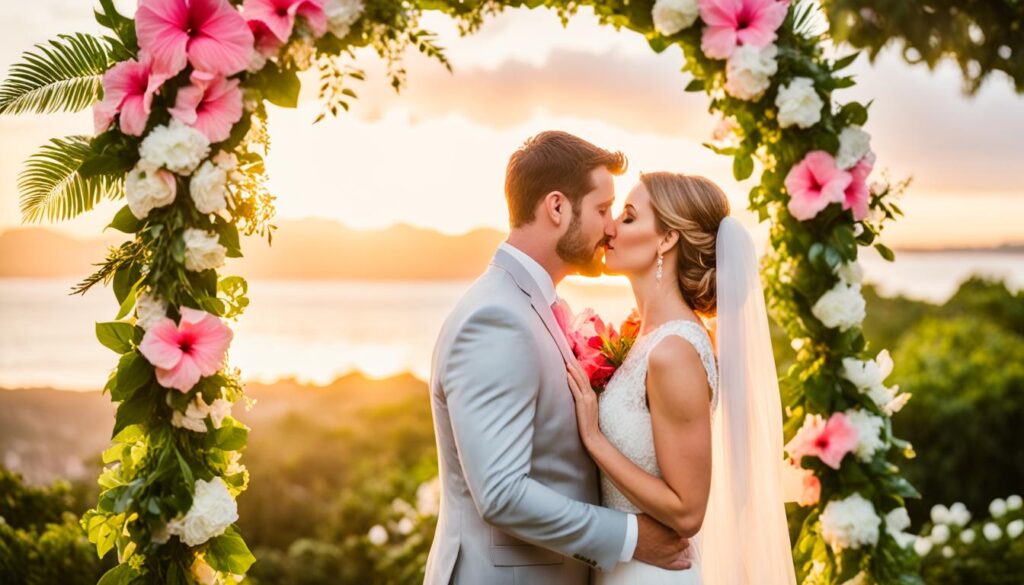
The Symbolism of Pink Hibiscus Flowers
In addition to their aesthetic appeal, pink hibiscus flowers also hold symbolic meanings that make them a meaningful choice for wedding decor. The color pink is often associated with love, romance, and femininity, making it an ideal choice for weddings.
The delicacy and beauty of hibiscus flowers can also represent the beauty of the bride and the love shared between the couple. Incorporating pink hibiscus flowers into the wedding decor adds depth and symbolism to the celebration, making it even more special and meaningful.
Whether used in bouquets, centerpieces, or as decorative accents, pink hibiscus flowers bring an element of natural beauty and romance to wedding decor. Their vibrant pink color and graceful petals create a visually stunning and unforgettable ambiance, setting the stage for a joyous and love-filled celebration.
How to Grow Pink Hibiscus Flowers Indoors
Growing pink hibiscus flowers indoors requires providing the right conditions. To ensure their healthy growth and vibrant blooms, consider the following factors:
Sunlight
Pink hibiscus plants thrive in bright sunlight. Place them in a location that receives at least six hours of direct sunlight per day. This ensures they receive the necessary light to promote robust growth and abundant flowering.
Temperature and Humidity
Hibiscus plants prefer warm temperatures between 60-85°F (15-29°C) and a humidity level of around 50-60%. Maintain a comfortable environment for your pink hibiscus flowers by avoiding drastic temperature fluctuations and providing adequate humidity. Consider using a humidifier if necessary.
Watering
Regular watering is crucial for the well-being of pink hibiscus flowers. Keep the soil consistently moist but not waterlogged. Monitor the moisture levels by checking the top inch of soil with your finger. If it feels dry, it’s time to water. Ensure proper drainage to prevent water accumulation and root rot.
Potting Soil
Choose a well-draining potting soil specifically formulated for tropical plants. This type of soil allows excess water to drain away, preventing waterlogging. Good drainage promotes healthy root growth and prevents the risk of root rot.
By providing the right growing conditions, including adequate sunlight, suitable temperature and humidity levels, regular watering, and well-draining potting soil, you can successfully grow pink hibiscus flowers indoors. Situate them in a bright and sunny spot, closely monitoring their needs, and enjoy the beauty of these tropical blooms in the comfort of your own home.
The Allure of Pink Hibiscus Flowers in Your Garden
Incorporating pink hibiscus flowers into your garden landscaping can add visual appeal and attract pollinators. Pink hibiscus plants serve as a nectar source, attracting butterflies and hummingbirds to your garden. Their vibrant blooms create a beautiful focal point or can be used as part of a larger planting scheme to enhance the overall aesthetic of your outdoor space.
With their striking pink petals and captivating beauty, pink hibiscus flowers are sure to catch the eye and bring a touch of elegance to any garden. Whether planted in a flower bed, a container garden, or along a pathway, these stunning flowers add visual appeal and create a focal point that draws attention and admiration.
One of the most enticing features of pink hibiscus flowers is their ability to attract pollinators. These plants provide a rich source of nectar, making them irresistible to butterflies and hummingbirds. By incorporating pink hibiscus into your garden, you not only create a visually stunning display but also support the ecosystem by providing a nourishing nectar source for these important pollinators.
Butterflies are highly attracted to the vibrant colors of pink hibiscus flowers and will flutter around, adding a sense of movement and liveliness to your garden. The delicate and graceful nature of these winged creatures perfectly complements the beauty of the hibiscus blooms, creating a harmonious and enchanting scene.
In addition to attracting butterflies, pink hibiscus flowers also allure hummingbirds. These tiny, fast-flying birds are drawn to the nectar-rich blooms, hovering near the flowers and sipping the sweet nectar. The vibrant colors and trumpet-shaped petals of the hibiscus flowers are perfectly designed to catch the attention of these amazing creatures.
By planting pink hibiscus in your garden, you not only enhance the visual appeal of your outdoor space but also create a haven for pollinators. Watching butterflies and hummingbirds flit and flutter among the blooms adds an extra dimension of beauty and joy to your garden experience.
Whether you’re a passionate gardener looking to enhance your garden landscaping or someone who simply appreciates the beauty of nature, incorporating pink hibiscus flowers into your outdoor space is a wonderful choice. With their vibrant colors, captivating allure, and ability to attract pollinators, these gorgeous blooms are sure to transform your garden into a haven of natural wonder.
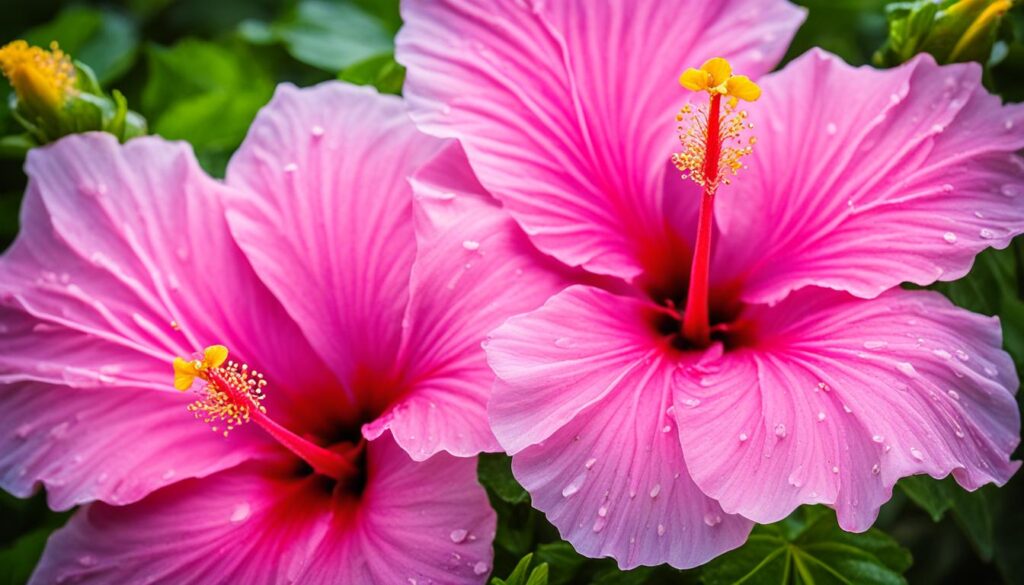
The Visual Appeal of Pink Hibiscus Flowers in Your Garden
| Benefits of Pink Hibiscus Flowers | Examples of Visual Impact |
|---|---|
| 1. Stunning focal point: Pink hibiscus flowers create a captivating centerpiece in garden landscapes, drawing attention and admiration. | 1. Flower beds: Plant rows of pink hibiscus along a flower bed to create a striking display of color. |
| 2. Blooming borders: Use pink hibiscus plants to line the borders of your garden, adding vibrant pops of color that define and enhance your outdoor space. | 2. Mixed plantings: Combine pink hibiscus flowers with other colorful blooms to create visually stunning and diverse plantings. |
| 3. Potted arrangements: Plant pink hibiscus in decorative containers to add a touch of elegance to patios, balconies, or other outdoor areas. |
Conclusion
Pink hibiscus flowers, also known as Hibiscus rosa-sinensis, are a breathtaking addition to any garden or indoor space. With their vibrant petals and exotic blooms, these tropical flowers bring a touch of beauty and elegance to any landscape. By providing the right care and growing conditions, you can create stunning displays that showcase the allure of pink hibiscus flowers.
Whether you’re drawn to their visual appeal, fascinated by their healing properties, or intrigued by their cultural significance, pink hibiscus flowers have a special place in the world of flora. These flowers can be used to enhance garden landscaping, attract pollinators, and create a sense of natural wonder. Their vibrant colors and striking petals make them a true delight for the eyes.
So why not embrace the beauty of pink hibiscus flowers and let them transform your garden into a captivating oasis? Whether you’re looking for a tropical touch or a vibrant focal point, pink hibiscus flowers are the perfect choice. Explore the different varieties available, experiment with different planting schemes, and enjoy the exotic blooms and vibrant petals of these stunning flowering plants.

